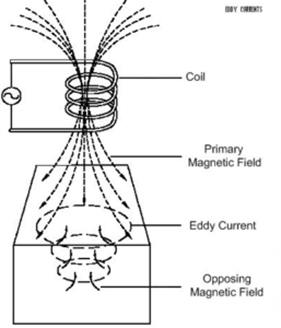Science > Physics > Electromagnetic Induction > Eddy Currents
If a block of metal is moved in a magnetic field or kept in a changing magnetic field, the free electrons in the conductor experience force and begin to circulate. This gives rise to induced currents in closed circular paths and it is known as eddy current or Foucault currents. These induced eddy currents flow in the form of eddies in such a direction so as to oppose the motion of the conductor in the field.
Eddy currents produce a large amount of heat in the soft iron core of transformers, induction coil, electric motors, etc. This results in a decrease in the efficiency of such machines. However, eddy currents can be usefully employed in many electrical devices.

Uses of Eddy Currents:
Deadbeat Galvanometer:
The coil of a moving coil galvanometer which is used for measuring current is wound on a copper or aluminium frame. When a current flow, the coil gets deflected and as soon as the current stops the coil tends to oscillate about its equilibrium position. However, the eddy currents generated in the metal frame opposes the oscillatory motion. As a result, it to oscillate. This makes the moving coil galvanometer deadbeat.
Induction Motor:
The induction motor consists of a long metallic axle mounted lightly in a uniform magnetic field with its axis at a right angle to the field. If the magnetic field is rotated with respect to the stationary axle, eddy currents are developed in it. The eddy currents thus produced try to reduce the relative motion by rotating the axle in the same direction of rotation of the magnetic field. This is the principle of an induction motor.
Induction Furnace:
The heating effect of the eddy current is used for melting metal in an induction furnace. Eddy currents of large magnitude are produced field. The changes in the magnetic field are so rapid that very large eddy currents are generated and heat produced is sufficient to melt quickly. An induction furnace is used for producing alloys of different metals.
Electric brakes:
It is an efficient system of brakes employed in electric trains. The axle of a train is surrounded by a coaxial cylindrical drum. When the train is to be stopped, a strong magnetic field is applied to the rotating drum. This results in the generation of large eddy currents which oppose the relative motion between the stationary field and the axle. Thus the train slows down and comes to rest quickly and smoothly.
Speedometer:
In a speedometer, the magnet rotates inside a pivoted metallic drum. The speed of rotation depends on the speed of the vehicle. Eddy currents in the drum cause the magnet to rotate with the drum. It rotates through an angle which is proportional to the speed of the vehicle. A pointer attached to the magnet gives a reading of the speed of the vehicle on a calibrated scale.
Disadvantages of Eddy Currents:
- There is a major heat loss during cycling eddy currents due to friction in the magnetic circuit, especially where the core is saturated. Thus there is the loss of useful electrical energy in the form of heat.
- There is magnetic flux leakage.
- To avoid losses due to eddy current the core of induction coils and transformer is not constructed as a block but og number of thin strips.
2 replies on “Eddy Currents”
Thank you very much for your hard work it is really useful and I bet others will find it useful too we really appreciate it keep it going and wish you the best.
Thanks alot for your contribution towards education.